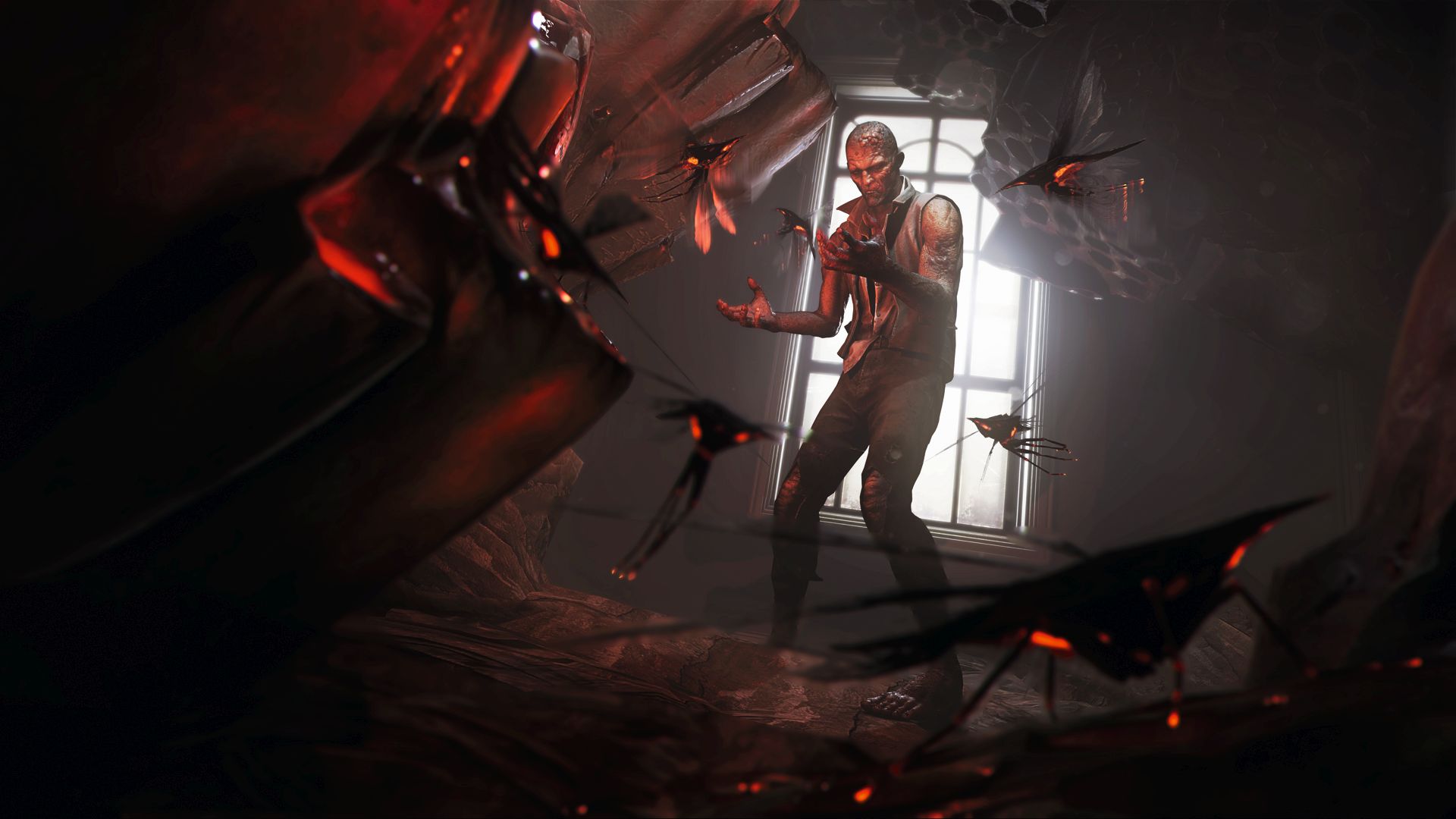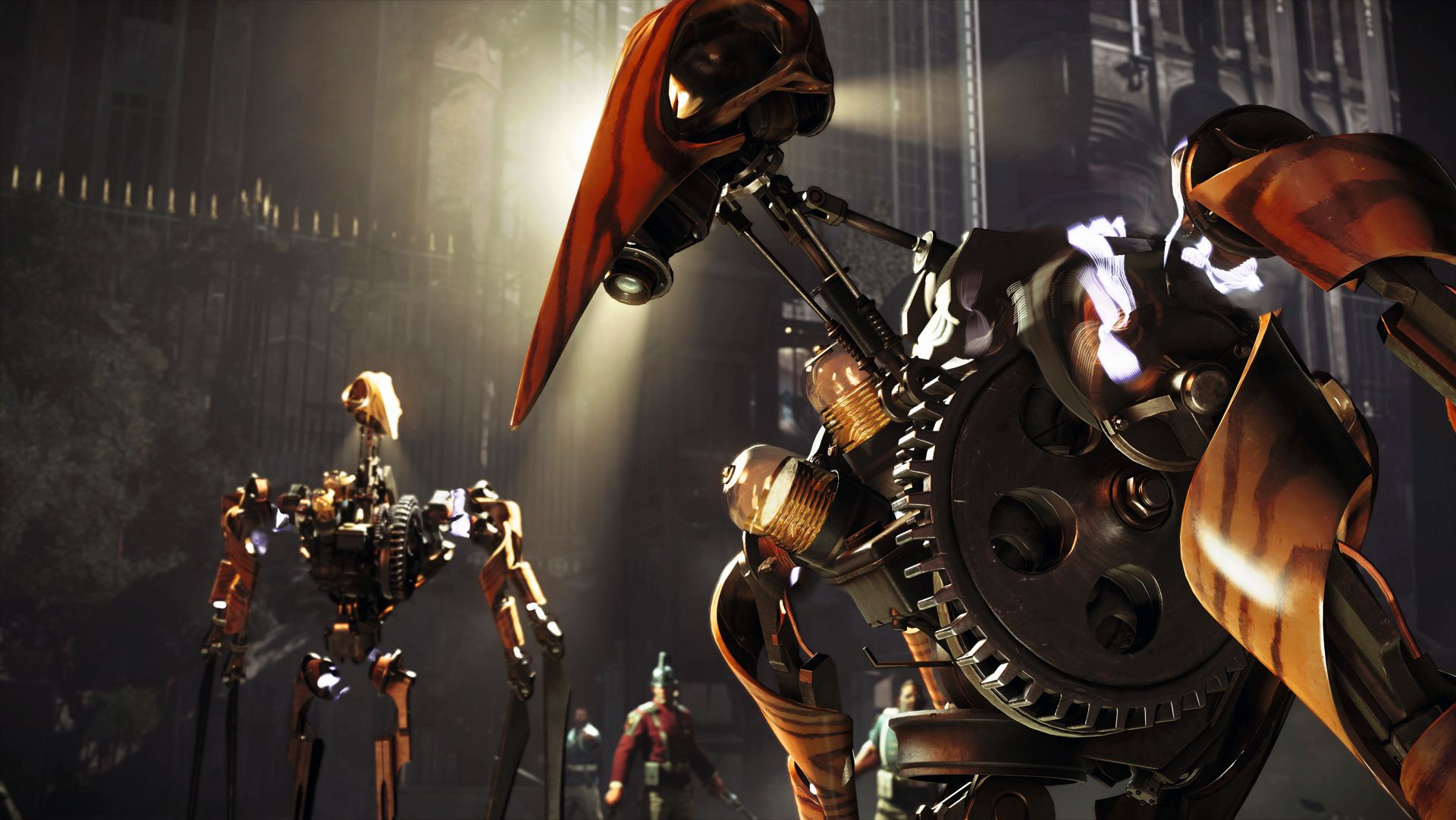Dishonored 2: creative killing in Karnaca
The sequel hopes to establish a spectacular new legacy for the stealth genre.

“I always wanted people to be impressed with the visual and to get a new sense of the city,” he continues. “Dunwall is more shadowy and the bodies were hidden in corners. We’ve put them in the middle of a sunny place. And when you’re there you’ll see the bodies, how the body reacts to the sun, then you can ‘smell’ what happens next. It’s on purpose—I try to bring sense that we don’t have when you’re facing a screen.”
Although Emily is the breakout star of this new story, it’s easier to explain changes to Dishonored’s underlying structure with Corvo as a reference point. He hasn’t changed much—he retains all of his powers from the first game, although they can now be customised in different ways. Each power in Dishonored could receive a single major upgrade, but now each has a branching tree of options. Corvo’s Blink, for example, can be turned into ‘Reactive Blink’—Arkane’s name for Daud’s variant on the same power in the Knife of Dunwall expansion. This allows you to freeze time when you charge Blink, allowing for better decision-making in the heat of battle.
Corvo can now leap from one possessed body directly into another, and modify Bend Time so that he can stop time completely before moving it forward in small increments. While Emily encounters bloodflies as a dangerous nuisance, for Corvo they’re an opportunity—he can possess them and fly around. Bloodflies are one of the ways that the chaos system manifests in the new city, as nests appear in great numbers as the player’s kill-count increases. This also happens dynamically within the course of each mission, with carelessly-discarded corpses quickly becoming hives if left alone. As with anything in Dishonored, this can help or hinder—it just depends what your plan is.
Chaos was a contentious system in the first game because it seemed like a punishment for playing violently, which sat at odds with the fact that the game’s most entertaining powers were lethal. Playing non-lethally meant forgoing many powers and gadgets and remaining unseen, because getting caught usually meant having to kill whoever had found you. Arkane has balanced the idea better this time, offering non-lethal variants on certain combat moves. You can take a guard as a human shield and choke them unconscious mid-battle this time, and there’s a version of the drop-assassination that knocks somebody out. There are flashbang bolts for your crossbow, and so on. Not only is it still possible to complete the entire game without killing anybody, but doing so supports a more active playstyle alongside the ‘ghost’ approach.

“Some people were wondering if Chaos was making the game too difficult,” says lead designer Dinga Bakaba. “‘Hey, wait a minute, you’re punishing me!’ It’s not making the game more difficult, it’s making an experience where you deal with the consequences. There’s probably more security, but it’s not like suddenly you have less health or fewer powers.”
There’s an increased emphasis on finding multiple uses for powers, already a strong theme of the series. Emily has an entirely new skillset built with this in mind. Instead of Blink, she has Far Reach—throwing out a smoky tendril, she latches on to parts of the environment and pulls herself towards them. It’s a little slower than Blink, but goes further and has many more uses besides. Far Reach can be used to pick up items and, when upgraded, you can snatch enemies and hoist them up in the air for swift dispatching. You can grab whale oil canisters and fling them backwards over your head. Unlike Blink, Far Reach retains the momentum you have when you cast it, so you can sprint into a long grapple and then fall out of that into a slide. That a few players made an acrobatic art of the first game’s combat system did not go unnoticed, and they’ll have more to play with here.
The success of the first game means that Arkane has the freedom, with Dishonored 2, to double-down on its strengths. There’s no pressure to make a simpler or more traditionally marketable offering, as has happened with games like this in the past. “When we made Dishonored we weren’t really sure how it’d be received,” Bakaba says. “It’s weird when you say it now, but I can tell you that until the very end, when the first reviews came, we were thinking ‘maybe this industry doesn’t want this type of game’. That is now in the past, that fear. This time we approached it like ‘OK, they like what we’re doing, what we’re passionate about, how can we improve.’”
The biggest gaming news, reviews and hardware deals
Keep up to date with the most important stories and the best deals, as picked by the PC Gamer team.
The team are also guided by their success, particularly when it came in forms that they didn’t expect. “For whatever reason, we have a wider range of demographics who like our game than is traditionally true and I love that,” Harvey Smith says. Dishonored 2’s two protagonists represent one way that the sequel celebrates this diversity, and the cast of principal characters is another. “I love writers like Ta-Nehisi Coates who talk about how important it is to have a representational avatar for a comic or a game,” Smith says. “Not just a grizzled white dude. That’s an easy trap to fall into. We found that the more we include other types of people in the world, the more it resonates with a wider range of people and it doesn’t hurt the core audience at all. It doesn’t hurt the core fantasy at all.”
That is the ultimate sign of the health of this genre, I think. It hasn’t simply been rescued from the past: Dishonored has helped establish a new future for the immersive sim, one where it can enjoy commercial success and critical acclaim and expand the industry’s sense of who games might be for. Heir to a rich legacy, Dishonored 2 finds itself in a good position to exceed its ancestors later this year.
Joining in 2011, Chris made his start with PC Gamer turning beautiful trees into magazines, first as a writer and later as deputy editor. Once PCG's reluctant MMO champion , his discovery of Dota 2 in 2012 led him to much darker, stranger places. In 2015, Chris became the editor of PC Gamer Pro, overseeing our online coverage of competitive gaming and esports. He left in 2017, and can be now found making games and recording the Crate & Crowbar podcast.


